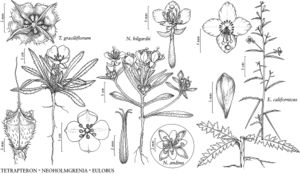Tetrapteron
Syst. Bot. Monogr. 83: 129. 2007.
| Taxon | Illustrator ⠉ | |
|---|---|---|
 | Tetrapteron graciliflorum Neoholmgrenia hilgardii Neoholmgrenia andina Eulobus californicus |
Herbs, annual, usually acaulescent, sometimes with very short lateral stems; with slender taproot. Stems (when present) thickened, becoming tough in age, with loose, white, exfoliating epidermis. Leaves in a basal rosette; stipules absent; sessile; blade margins entire or sparsely serrulate. Inflorescences solitary flowers in leaf-axils. Flowers bisexual, actinomorphic, buds nodding, becoming erect; floral-tube deciduous (with sepals, petals, and stamens) after anthesis, with fleshy nectary disc near base; sepals 4, reflexed in pairs; petals 4, yellow, unspotted or with red basal spot, strongly ultraviolet reflective; stamens 8 in 2 unequal series, anthers subbasifixed, pollen shed singly; ovary 4-locular, with slender, tubular, sterile apical projection 6–45 mm proximal to floral-tube, with visible abscission lines at its junctures with both fertile part of ovary and short floral-tube, style glabrous or shortly pubescent, stigma entire, globose, surface unknown, probably wet and non-papillate. Fruit a capsule, obovoid, with pointed wing near center distal portion of each valve, very tardily dehiscent in distal 1/2 only and persistent on plant, often blackened, apical sterile projection often breaking off; subsessile. Seeds few to numerous, in 2 crowded rows per locule, obovoid or narrowly obovoid, finely papillose, tan with dark splotches or brown. = 7.
Distribution
w United States, nw Mexico
Discussion
Species 2 (2 in the flora).
P. H. Raven (1969), like R. Raimann (1893) and others, placed together all species of Camissonia with a sterile apical projection on the ovary; however, it is clear from molecular evidence (R. A. Levin et al. 2004; W. L. Wagner et al. 2007) that the perennial species with this feature (Taraxia) are distinct from annual species (Tetrapteron) and do not share an immediate common ancestor with them. Tetrapteron has distinctive capsules that differ from those of other genera in its irregularly obovoid shape, woody walls, and especially the pointed wings on the distal half of each valve. In addition, species of Tetrapteron are acaulescent or nearly so and have anthers intermediate between the basifixed anthers of Taraxia and its close relatives, and the versatile anthers of other species in the former Camissonia. The two species of Tetrapteron often occur on clay soil and retain their seeds very late, long after the plant has otherwise died and shriveled, which probably accounts for their unique capsular attributes. Steve Boyd (unpubl.) has observed that T. graciliflorum has hygrochastic capsules and suspects that T. palmeri also does. Reproductive features include: self-compatible; flowers diurnal; autogamous and, sometimes, cleistogamous, or in T. graciliflorum rarely outcrossing and pollinated by small bees or flies (Raven). The unusual sterile projections on the ovary in Taraxia and in Tetrapteron are presumed to have arisen independently. The species of both are acaulescent, so that the projection on the ovary raises the flowers above the leaves and, presumably, makes them accessible to pollinators (R. A. Raguso et al. 2007).
Selected References
None.
Lower Taxa
Key
| 1 | Herbs densely pilose; leaf blades linear to narrowly lanceolate; petals 5–18 mm; floral tubes 1.6–3.2 mm. | Tetrapteron graciliflorum |
| 1 | Herbs sparsely to moderately strigose and sometimes also sparsely pilose; leaf blades narrowly oblanceolate; petals 2–5 mm; floral tubes 0.8–1.3 mm. | Tetrapteron palmeri |